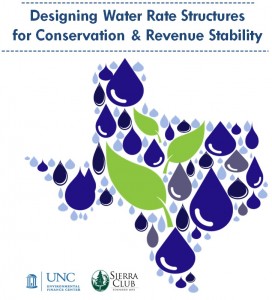by Jacob Mouw
This post was revised on September 25, 2014 to address nuances of water pricing and differences in conservation rates.
 Drinking water, despite being a necessity, is relatively cheap in regards to its importance. At around $0.005 per gallon from the tap, it is astoundingly cheaper than, say, printer ink, which ranges from $13 to $75 per ounce, and yet is vastly more important. Despite this low price, water is a commodity, particularly in dry, drought-prone regions such as the southwestern United States. Utilities can deal with low water supplies by discouraging higher water use among customers through pricing. Having a “conservation rate” entails charging high enough prices for larger volumes of water use, therefore discouraging discretionary, non-essential use and promoting conservation. In the Environmental Finance Center’s recent Water and Wastewater Rates and Rate Structures Survey in the State of Arizona, thanks to funding from the Water Infrastructure Finance Authority of Arizona, we analyzed 355 water rate structures from 324 utilities. Continue reading
Drinking water, despite being a necessity, is relatively cheap in regards to its importance. At around $0.005 per gallon from the tap, it is astoundingly cheaper than, say, printer ink, which ranges from $13 to $75 per ounce, and yet is vastly more important. Despite this low price, water is a commodity, particularly in dry, drought-prone regions such as the southwestern United States. Utilities can deal with low water supplies by discouraging higher water use among customers through pricing. Having a “conservation rate” entails charging high enough prices for larger volumes of water use, therefore discouraging discretionary, non-essential use and promoting conservation. In the Environmental Finance Center’s recent Water and Wastewater Rates and Rate Structures Survey in the State of Arizona, thanks to funding from the Water Infrastructure Finance Authority of Arizona, we analyzed 355 water rate structures from 324 utilities. Continue reading










